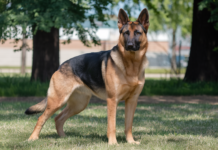Last Updated on September 29, 2023 by Dogs Vets
How to Properly Brush Your Dog’s Teeth for Optimal Oral Health
If you’re a pet owner, you understand the importance of your furry friend’s oral health.
Just like humans, dogs can suffer from dental issues that can lead to pain and discomfort if not properly addressed.
In this comprehensive guide, we’ll walk you through the essential steps to ensure your dog’s teeth stay healthy and clean.
Why Your Dog’s Dental Health Matters
Your dog’s dental health is more critical than you might think. Poor oral hygiene can lead to bad breath, gum disease, tooth loss, and even more severe health problems.
By taking care of your dog’s teeth, you’re ensuring their overall well-being.
The Essential Supplies
Before you begin, gather the necessary supplies:
- A dog-specific toothbrush
- Toothpaste designed for dogs (never use human toothpaste)
- Optional dental chews or treats.
Step-by-Step Guide to Brushing Your Dog’s Teeth
1. Introduction
Introduce your dog to the toothbrush and toothpaste. Let them sniff and taste the toothpaste to make them comfortable with the process.
2. Positioning
Position your dog in a comfortable spot, ideally at their eye level. You can use a pet-specific toothbrush or a finger brush.
3. Brushing Technique
Gently lift your dog’s lips and start brushing their teeth in a circular motion. Focus on the outer surfaces of the teeth. Use a gentle but firm pressure.
4. Be Patient
Start with short brushing sessions and gradually increase the time as your dog gets used to it. Always reward them with praise and treats.
5. Frequency
Aim to brush your dog’s teeth at least 2-3 times a week for optimal results. Regularity is key to maintaining good oral health.
FAQs
Can I use human toothpaste for my dog?
No, human toothpaste contains ingredients that can be harmful to dogs. Use toothpaste specifically formulated for dogs.
Are dental chews a suitable alternative to brushing?
While dental chews can help, they should complement brushing, not replace it. Brushing remains the most effective method.
What if my dog resists brushing?
Be patient and go slow. Allow your dog to get comfortable with the process gradually.
When should I start brushing my dog’s teeth?
Start brushing your dog’s teeth when they are puppies to establish a routine.
Can I use a regular toothbrush?
It’s best to use a toothbrush designed for dogs, as their bristles and shape are tailored for canine teeth.
How can I prevent plaque and tartar buildup?
Regular brushing, dental chews, and a balanced diet can help prevent plaque and tartar.
When should I consult a vet?
If you notice signs of dental issues like bad breath, bleeding gums, or difficulty eating, consult your vet promptly.
By following these steps and maintaining a consistent oral hygiene routine for your dog, you’ll ensure they have the healthiest teeth and gums possible.
Remember that your dog’s oral health is a crucial part of their overall well-being, so invest the time and effort to keep those pearly whites in top shape.
Source References and Links:
- American Veterinary Medical Association – Tooth-Brushing Process
- Veterinary Oral Health Council – VOHC-Backed Dental Products
Now that you have a detailed guide on brushing your dog’s teeth, let’s explore more ways to keep your furry friend healthy and happy. Read on for expert tips and advice on everything pet-related.
Fact Check
We strive to provide the latest valuable information for pet lovers with accuracy and fairness. If you would like to add to this post or advertise with us, don’t hesitate reach us. If you see something that doesn’t look right, contact us!
Disclaimer: This article is for informational purposes only and should not replace professional veterinary advice.

















